In the past year, while remodeling my house, I’ve spent approximately 80 percent of my time and 140 percent of my patience dealing with a home improvement store. As one example of this journey, when I called to check the status on my windows order, I was told they weren’t sure where in the U.S. it was.
During the two week process of locating the order, I had to call and re-explain the situation to nearly everyone in the windows department. I even tweeted their corporate office, who told me to email them, and they then provided incorrect information via email. The process convinced me that this business truly did not care about my experience with their brand.
But the truth is that it’s not really the company’s fault. Here’s how information and data would have had to flow for me to get the experience I wanted:
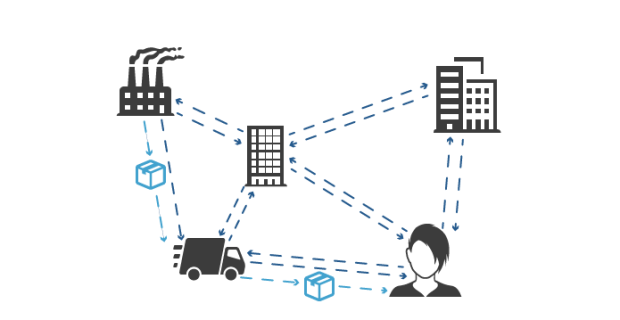
Just to fulfill my purchase to my expectations, my order information had to travel from the local office systems to the manufacturer’s, the delivery company, and the corporate headquarters. Then feedback about the physical goods and my interactions with different levels of customer support had to flow back through all these systems.
As a digital marketer, I see why this is hard. But as a customer, I still expect the company to know my order and use that knowledge to provide timely service — and your customers likely feel the same way.
That’s where the joys and pains of Big Data comes in.
Customers are handing over a ton of data
Human life today is more quantifiable than it has ever been: 90 percent of the world’s data was created in the past two years alone. As we’ve translated difficult-to-compute offline interactions to highly countable digital activities, we are creating a ton of data.
Loosely, this boom of data along with the growth of technologies to manage it is referred to as “Big Data.” However, eConsultancy found that this term isn’t clearly or universally defined:
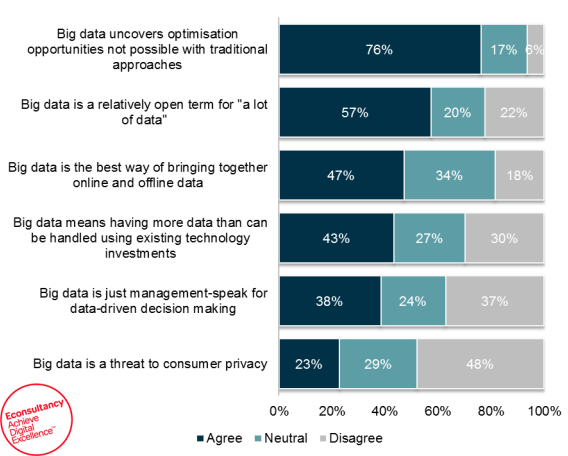
For our purposes, let’s agree that the importance of Big Data is the ability to make smarter decisions and better serve customers by analyzing a wealth of information.
On the fun side, that means we can predict buying behavior based on your zip code (try it, it’s eerie) and even guess your age based on your name.
More practically, Big Data means a different way of forging relationships with customers. As Sridhar Ramaswamy wrote on the Think With Google blog, “in our constantly connected world, a device is just a proxy for getting to know your customers.”
Before Big Data, a customer might think of something they need, go into a store they know, ask a sales associate and then make a decision. Now, they might search around online, go to your site and look for specific products or features, ask friends, and then eventually buy — all while leaving a trail of breadcrumbs letting you know who they are and what they want.
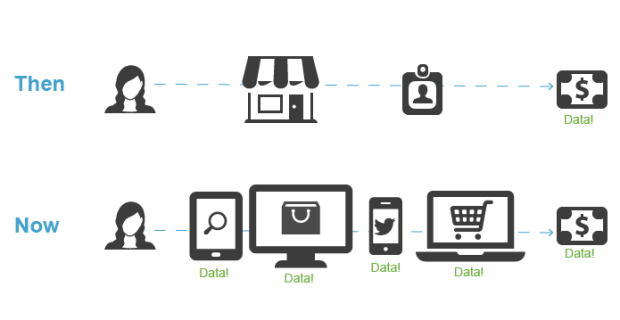
By analyzing those breadcrumbs, you can provide better service to happier customers while growing your business.
Customers expect relevant, consistent experiences
In return for handing over data, customers expect a highly personal experience, and will reward shops that provide it.
These expectations mirror what customers have always wanted. In the old days, good salespeople paid attention to the needs of their customers and tailored their approach. Today, your website, email and social experiences have to do the same.
Companies like Amazon have used Big Data to do exactly this. Just look at my personal Amazon homepage:
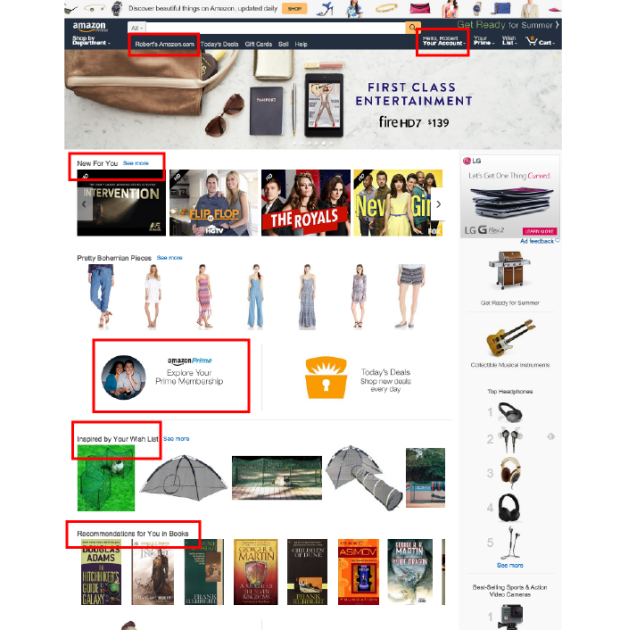
Recently, I even saw a dashboard showcasing my orders on the homepage:

All of these touches are ways that Amazon is creating a seemingly individual relationship with legions of customers.
Airbnb delivers a similarly personal relationship right to your inbox when you check out a listing but don’t book. They send you a personal email with both the details for the listing you viewed and additional recommendations:

By sending you this email, AirBnB is both reminding you about an important booking you might have forgotten, but also making it easier for you to finish your task. It’s a considerate and personal touchpoint aimed to help customers achieve their goals.
Personalized experiences based on data can also provide valuable feedback to retain customers. Take this TripAdvisor example:
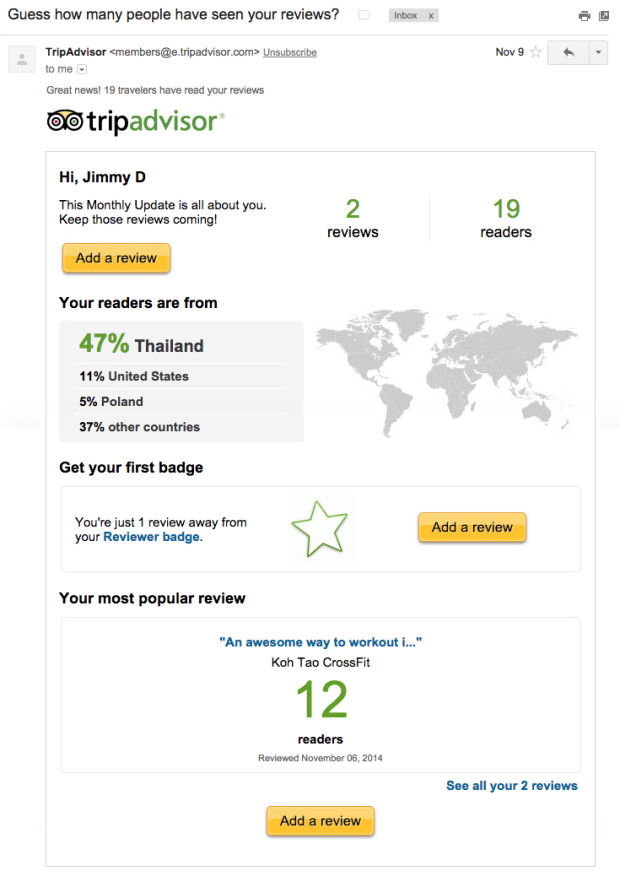
Here, TripAdvisor creates an individual connection by aggregating feedback about your reviews and even showing you the best review that you have personally submitted.
On the backend, this email means a pretty deep integrations between TripAdvisor’s email and review systems, including emails triggered by review behavior and review content and analytics pulled directly into email content. On the front end, the customer just sees that TripAdvisor communicates with them individually.
As customers interact with more companies like this, their expectations change. Personalized recommendations are no longer delightful, they’re expected. And customers are bringing those expectations with them when they interact with you — just like I did with the home improvement company.
Big Data is still expensive
While the insights gained from Big Data can be astounding, there’s a dirty secret: Big Data isn’t free and can be extremely complicated.
At the very least, Big Data initiatives require:
- Complex tracking technologies to turn every action into data
- Technical resources to setup or manage integrations that move data, in real-time, between disparate systems
- Massive storage to hold all the amazing data
- Data scientists to mine the data and extract valuable actionable insights
- Marketing and technical resources to act on the knowledge gained
Building a stack of systems that work together to track customer data, serve actionable insights and automatically create better experiences for customers is incredibly hard. Building it to scale is even harder.
Practical E-Commerce suggests that hiring data scientists, outsourcing the work or relying on free tools is the solution, but contractors and free tools still have to be managed. The long and short of it is that while Big Data may be the silver bullet to take us away from impersonal online experiences and towards serving our customers as individuals, it’s still out of reach in many ways.
Given the challenges, it’s unlikely that a head-first deep investment in Big Data is right for your store. However, starting with the mindset of trying to create more relevant, personal experiences for customers, there are ways to dip your toe into the data pool and take steps now to put you on the path to success later.
Get started by tracking your customer interactions
Before you can act on data, you have to collect a large enough dataset from which to draw meaningful conclusions. Investing some time and energy in a solid, scalable data infrastructure will save you headaches down the line and help you build historical data from day one.
We recommend starting with old faithful: Google Analytics. You can easily set this up with the WooCommerce Google Analytics Integration plugin.
Once you have enough data — preferably a minimum of a month’s worth — you can start to get some answers. A few places to start:
- Channels: Find out how customers are finding your site with the channel report and then look at how each channel is converting. This will tell you which acquisition channels are making the biggest difference for your store specifically.
- Exits: Look at pages where users are leaving at a higher rate and think about why those pages aren’t meeting expectations.
- Audience: More than anything, Big Data is about knowing your customers so you can create tailored experiences. Check out Google Analytics Audience Insights to learn about your audience’s interests. Building a better understanding of what else your audience is interested in can help you tailor your content and offerings.
Integrate an email tool to send one-to-one messages
Websites and social media are public channels, meaning no matter how hard you try, someone outside your target audience could stumble in and see something that isn’t relevant. In terms of marketing channels, email is often hailed as the holy grail of personalized experiences because targeting is built right in: you get to pick who receives your message.
With that in mind, it makes sense to invest in an email tool early on to start collecting individual customer-level data that you’ll be able to act on later.
To get started, tools like MailChimp offer a free option to manage your list and integrate email capture forms into your site. If you’re using WooCommerce, consider the Newsletter Subscriptions plugin to automatically give customers the option to opt-in to an email list. This will give your customers the option of subscribing to email, where you can later target them with special offers.
As you add email capture forms, think about what the different types of customers you might want to target. Then, make sure to capture the relevant data on the sign-up form. For example, if you sell apparel to both men and women, you might want to send different offers based on the gender of the recipient, so ask about gender on your signup form.
As another example, Doggyloot, which sells toys and treats that owners can spoil their pups with, asks about the size of your dog right up front:

Then, they send segmented emails for small dog owners and large dog owners. This move increased their click-through rates by 410 percent.
Another simple way to get started is optimizing your email send time based on a customer’s time zone – especially important for stores serving a global audience. MailChimp recently tested this on their own emails and saw a 14 percent increase in opens.
To go a step further, consider using a tool like the Get Drip plugin to run automatic campaigns based on your customer’s actions. For example, you can send a specific follow-up email for customers a week after customers purchase one product with ‘get started’ guide or an offer for a companion product.
Create a relevant website experience with recommendations
Store owners and customers alike benefit from personalized recommendations. Store owners see increased revenue by offering relevant products. Customers find more options without having to manually search.
Out-of-the-box, WooCommerce provides the option to add related products to a product page. This gives your customers relevant suggestions to click through as they browse your store.
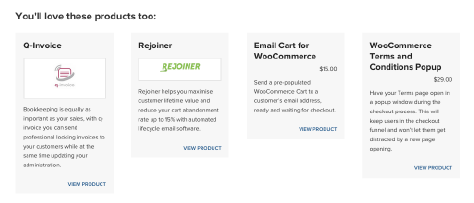
A word of caution: results will vary
Of all the many ways that data has grown, the most difficult to manage is the complexity and variability. Just like each customer has unique needs, barriers, and goals, every tool is built with its own conventions in order to accomplish particular tasks. The result is a huge variety of data.
Furthermore, each store has unique data needs and a unique customer base, so the insights that are highly valuable to one store might be meaningless to another.
This post is meant to be a starting point, but it is far from guaranteed to work exactly as we’ve outlined here. Because each case is so different, the best way to find out what will work for you is to try things, play around, and build up your own knowledge.
Conclusion
In the age of the digital customer, data is anywhere and everywhere. The challenge to store owners is how to properly build a system to manage the data, provide actionable insights and, ideally, provide automatic value to the customer whenever possible.
While the right implementation for each company is complex and varied, you can dip your toe into Big Data by:
- Setting up Google Analytics to track your customer’s interactions and view simple reports to start learning more about them
- Integrate an email tool into your marketing stack to communicate with your customers directly, either through automated emails based on activity or segmented emails based on data you capture
- Create a relevant website experience using tools like relevant recommendations
What’s been your experience trying to integrated data into eCommerce? Feel free to share any great successes or deep frustrations in the comments — we would love to hear how you’re tackling these topics for your store.
Header image credit: r2hox

One Response
Trackbacks/Pingbacks